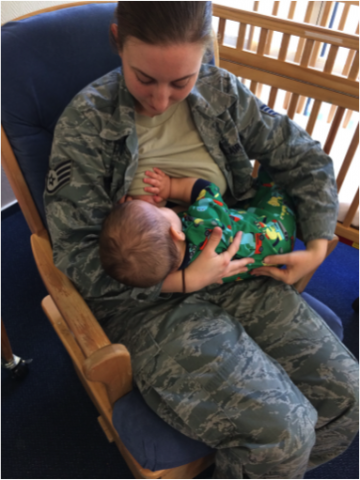
#MilitaryMonday: The New Military Parental Leave--What does it really mean?
Paid Family Leave for military families has rapidly changed in the past two years, and the 2017 National Defense Authorization Act brings even more changes. While some of these changes appear to be improvements for military parental leave, several points of the new law have left us with some serious concerns.
First, a bit of history. For years, the Department of Defense authorized NO maternity leave, only 6 weeks of “convalescent leave” for female active duty servicemembers after giving birth. In 2015, the Navy and Marine Corps established a policy of 18 weeks of paid maternity leave for female servicemembers. Later that year, as part of the Force of the Future initiative, the DOD created a department-wide policy of 12 weeks of nonchargeable paid maternity leave for female servicemembers for all service branches. This increased the amount of leave for Army, Air Force, and Coast Guard personnel, but decreased the Navy and Marine Corps’ leave. The initiative noted that male servicemembers whose wives gave birth were authorized 10 days of nonchargeable parental leave, at the discretion of the command, and indicated the intent to seek Congressional approval to expand that to 14 days. Adoptive parents were already authorized 21 days of non-chargeable parental leave in conjunction with the adoption of a child. However, in cases where both parents are active duty, only one is permitted to take leave, and the DOD indicated the intent to expand adoptive leave.
While there were many good things about this policy, it decreased the Navy and Marine Corps’ existing maternity leave policy from 18 to 12 weeks and limited maternity leave to female servicemembers who had given birth to biological children. The language of this policy did not address the issues of foster children entering the family, same-sex couples, unmarried parents, or transgender servicemembers who become parents.
Senator Tammy Duckworth, while a member of the House of Representatives in 2015, introduced the Military Parental Leave Modernization Act, which sought to close all of the gaps and ensure 12 weeks of paid, non-chargeable parental leave for all military servicemembers, regardless of their gender, marital status, or whether they are the birth parent. It would apply to births, adoptions, children born to surrogates, and foster children entering the family. Although this bill never made it to the floor of the House, the Secretary of Defense did request that Congress authorize expansions in the 2017 NDAA to cover parental leave for the non-birth parent, and adoptive leave for both parents.
The final bill passed with this language:
“Section 521 of the enacted bill adopts the Senate provision which authorizes up to 12 weeks of total leave (including up to 6 weeks convalescent leave) for the primary caregiver in connection with the birth of the child.23 It also authorizes 6 weeks of leave for a primary caregiver in the case of an adoption of a child. Secondary caregivers could be awarded up to 21 days of leave in connection with a birth or adoption. This section requires the Secretary of Defense to prescribe regulations defining “primary” and “secondary” caregivers for the purpose of this leave benefit. The leave taken in connection with the birth or adoption may only be in one increment and must be taken within a year of the event. To be eligible for this leave, the individual must be a member of the active component or a member of a reserve component performing active Guard and Reserve duty or subject to an active duty recall or mobilization order in excess of 12 months. Although parental leave authorized by this provision is in addition to any other leave a service member may have earned, this section also would allow the Secretary of Defense to prescribe regulations that would require a service member to extend their service obligation or to incur a reduction in their existing leave in their account when taking parental leave. Section 521 of the final bill also adopted a Senate-proposed provision that adds Section 704a, Title 10 United States Code explicitly prohibiting any leave from being awarded to military service members outside of what is authorized by statute. According to the conference report, “The committee considers this provision necessary to clarify that military leave is established by law and may not be created without express congressional authority.” 24 “
The good and bad about the new bill:
Good: It attempts to recognize diverse families by using non-gendered language.
Bad: However, it leaves ambiguity, and instructs the DOD to define “primary and secondary caregivers.”
Good: It expands adoptive leave for a “primary caregiver” from 21 days to 6 weeks.
Bad: 6 weeks is half of the parental leave for adoptive parents proposed in the Military Parental Leave Modernization Act, and does not address when foster children enter a family.
Good: It authorizes “secondary caregiver leave” for up to 21 days.
Bad: It does not establish this secondary caregiver leave, nor does it instruct the DOD to do so, meaning that this “secondary caregiver” parental leave is still at command discretion.
Bad and confusing: It requires that any changes to military parental leave be Congressionally authorized, stripping the Secretary of Defense of the authority to establish leave regulations previously established under Section 704 of Title 10, United States Code.
However, it leaves great ambiguity as to whether any of the changes authorized in this bill may be enacted at this point, or if the DOD must seek yet another legislative approval to implement the directives from Congress.
The really bad:
This law cuts maternity leave down from 12 weeks to 6 weeks of convalescent leave, but authorizes an additional 6 weeks as optional, although it is unclear whose option it is--the DOD’s or the servicemember’s.
And then there’s this language: “...Would allow the Secretary of Defense to prescribe regulations that would require a service member to extend their service obligation or to incur a reduction in their existing leave in their account when taking parental leave.”
This means that ANY leave other than the 6 weeks of convalescent leave for postpartum mothers is NOT Paid Parental Leave. Instead, it becomes chargeable leave, and it gives the DOD two ways to collect. Either they can force servicemembers to use their accrued annual leave for “parental leave;” or they can extend their service obligation--meaning that the servicemember will owe an additional 21 days to 6 weeks at the end of their military contract.
Mom2Mom Global is a 501(c)3 nonprofit organization dedicated to breastfeeding support, education, and advocacy for military families. Within our membership, we are already seeing the negative effects of this bill. Because no clear guidance was issued from either Congress or the DOD, implementation has been left up to individual commands, leading to inconsistencies. Some fathers, for example, are being given 21 days of parental leave under the new law, while others are being told that no new policy has been issued, so they are only allowed 10 (or less). Some female servicemembers whose spouses give birth are being allowed 21 days of parental leave, while others aren’t being allowed any. Some adoptive families are getting leave for both parents, others are not.
We are also deeply concerned that this leave is authorized to be chargeable or to incur an additional service obligation (ADSO), as this goes completely against the intent and definition of paid parental leave. Paid parental leave is a separate benefit from annual leave, and should not count against the leave a servicemember accrues.
In addition, as far as we could find, there is no other case where an ADSO is incurred for taking approved leave. ADSO’s are generally incurred for entering training programs, graduate, doctoral, or postdoctoral programs, or for moving to a new duty station within a set amount of time of the end of a servicemember’s contract. In particular, it is an alarming precedent that the DOD now has the power to require extra time in service for family planning choices. This is a dangerous slippery slope to go down, and we wonder if the military will at some point in the future begin tacking on ADSO’s for reproductive procedures such as vasectomies or tubal ligations?
We hope that the new Secretary of Defense will issue instructions soon standardizing a DOD-wide policy that establishes paid parental leave to the fullest extent allowed by the 2017 NDAA, and that this policy will not permit family leave to be diminished to chargeable leave. Supporting military families when they welcome a new child is an investment in individual and family readiness, recruitment and retention, and better public health outcomes for the military population, which could save millions in military health care costs long-term. We implore the Secretary of Defense to honor the importance of military children, starting from the moment they join the family.






The views and opinions expressed in this post are those of the author(s) and do not necessarily reflect those of MomsRising.org.
MomsRising.org strongly encourages our readers to post comments in response to blog posts. We value diversity of opinions and perspectives. Our goals for this space are to be educational, thought-provoking, and respectful. So we actively moderate comments and we reserve the right to edit or remove comments that undermine these goals. Thanks!